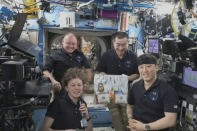Truth matters. Community matters. Your support makes both possible. LAist is one of the few places where news remains independent and free from political and corporate influence. Stand up for truth and for LAist. Make your year-end tax-deductible gift now.
After 19 years, a 'major lunar standstill' happened this week. Let us explain

Something that occurs every 18.6 years happened again on Sunday evening, Dec. 14. It's called a "major lunar standstill."
Griffith Observatory held a public viewing of the phenomenon, as well as an online viewing. More details on that later.
But first, without further ado...
What exactly is a major lunar standstill?
It's not an easy concept to understand, but don't take it from a layperson like me.
" It's not surprising that anyone would be confused about the whole idea of the major lunar standstill," said Ed Krupp, director of Griffith Observatory. " The motion of the moon really is complicated, and it is hard to visualize."
So let's start from the basics. The moon rises and sets every single day — and at some point each month, it reaches the farthest north it can go, and then back again to the farthest south it can go.
It's kind of like the summer and winter solstices — except the sun takes a year to reach its farthest most north and south points, while the moon does it every month.
It has to do with the moon's orbit
But here's the thing, the moon's orbit is actually changing all the time. Because as it swivels with respect to the earth and to the sun, these movements change the angle of its orbit.
" It's always moving around and wandering and changing its position," Krupp said. "That changes just how far to the north and how far to the south the moon may wind up going each month."
And these northward and southward creeps accumulate over time. To reach its farthest-farthest north takes 9.3 years. And it takes another 9.3 years for the moon to get to its farthest-farthest south.
Those combined 18.6 years represents the full cycle of this journey — aka major lunar standstill.
" So we're in that period of the so-called 'major lunar standstill,' and the last time that happened was 2006," Krupp said.
Is there a "minor" lunar standstill?
Why yes! That's when the moon is least far north and the least far south.
Krupp said on the Lower West Terrace of the Griffith Observatory are lines in the pavement that show these inner and outer lunar extremes.
Why is it called a "standstill"?
The term is borrowed from the word and concept of solstice — which means "sun still" in ancient parlance, Krupp said.
"When people were trying to come up with vocabulary for this behavior of the moon, they just drew the analogy from the sun called it the lunar standstill or the moon still," Krupp said.
Cool cool, remind me what's happening again tonight?
The moon will reach the most northern-northern-northern point it could go in the sky tonight — the first time in almost 19 years.
It's extra cool because it's also going to be a full moon.
And at the Griffith Observatory...
There's a public viewing on the front lawn of the observatory as the moon makes its ascent, along with a YouTube broadcast that starts at 5:03 p.m.
The moon, Krupp said, is estimated to rise at about 5:23 p.m.
Krupp will be on hand to speak to the crowd before, during and after the event.
All the info here.
But, what am I going to see exactly?
You'll regard the moon at a world-famous observatory in the world's best city on a lovely early Sunday evening — with the knowledge that you are part of something grander, vaster, and more immense than us mere mortals.
"There is nothing spectacularly different with the naked eye," Krupp said. "The moon will look just like it does."
In other words, simply breathtaking.
"Public understanding of the cosmos actually does help people feel like they're part of the cosmos, and understand where they are in it and when they are in it," Krupp said.











